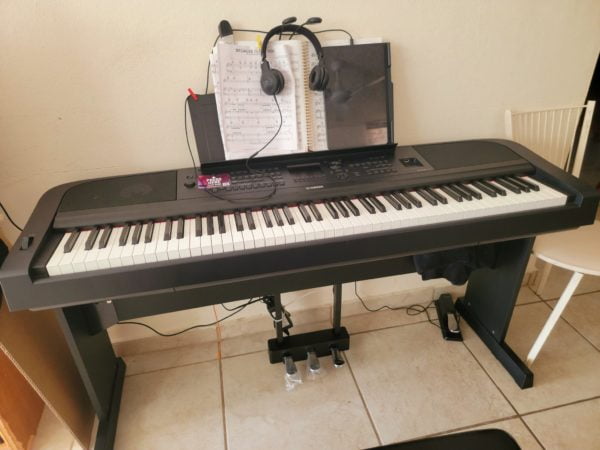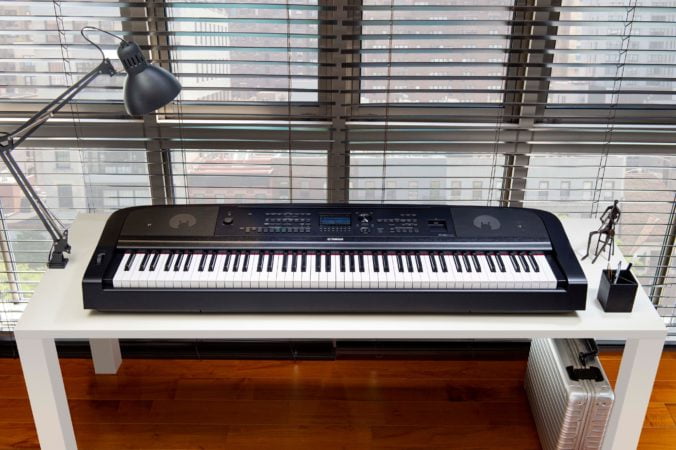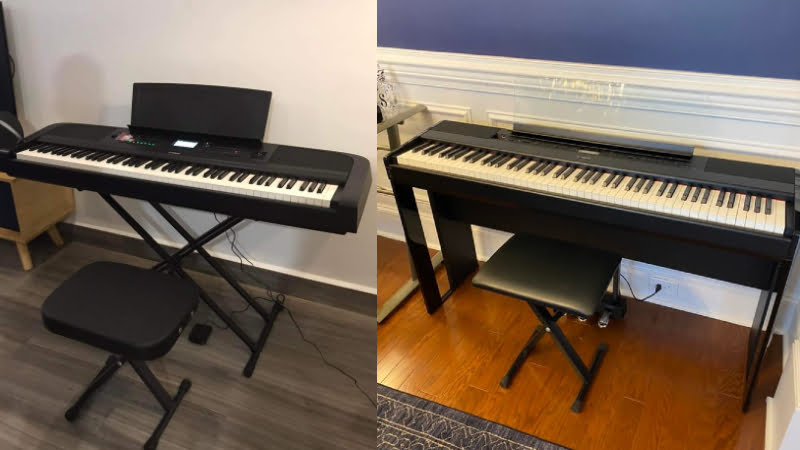Find out which between the Yamaha DGX 670 Vs P515 comes out on top of the Yamaha heap in this incredibly detailed comparative write-up.
I have tried several Yamaha digital pianos over the years and I am quite impressed with the work the company has put in every piece. If I were to rank all these, two pieces are leading: the DGX 670 and the P515. Top pianists and aficionados will agree with my assessment.
The Yamaha P515, packed with exceptional functions and features, is the flagship model of Yamaha’s P (Portable) Series. The Yamaha DGX 670, the newest model in Yamaha’s Portable Grand Series, is an amalgamation of three digital pianos – the P125, the PSR SX600, and the Clavinova.
Whichever you’ll get between the Yamaha DGX 670 Vs. P515, you can be certain that it is a piece that will truly satisfy and, more importantly, can last you a very long time. But if you want a comprehensive description of the various features of each so you can make a judicious decision, please read on.
Yamaha DGX 670 Vs P515: Comparison Chart




Last update on 2025-04-21 / Affiliate links / Images from Amazon Product Advertising API
Yamaha DGX 670 Vs P515: Head to Head Comparison
It is difficult choosing between these two Yamaha models. Even I had some trouble deciding which of the two would grace my living room because one, they share several really good features and two, each has its own unfortunate handicaps.
I have very little complaints about the elements of the two and I will be discussing those one by one below. But the major drawbacks do stand out and are usually pointed out by many.
For instance, the DGX 670 is so heavy that it is almost impossible to bring it anywhere. The word ‘portable’ in the Portable Grand Piano title is a huge misnomer. The P515, on the other hand, is quite pricey. And compared to the former which is fairly priced at $800, it’s hard to ignore the over $1,500 price tag of the latter.
The two are matched in many ways, but with the aforementioned particulars in place, the top spot goes to the DGX 670, which wins over the P515 2:1.
Feel and Playability
The Winner: Yamaha P515

There is very little to complain about the DGX 670 in this aspect. After all, it has what almost all Yamaha are equipped with: an impressive hammer action that other companies can’t seem to match. However, Yamaha upped its game with the P515 adding escapement and outfitting it with wooden keys.
+Hammer Action
Playing on an acoustic piano is such a wonder because the subtle nuances from the finger are impeccably conveyed to the strings under the instrument, creating the sound. This is precisely what Yamaha tried to accomplish with their Graded Hammer Action found in most of their pieces including the DGX 670.
The P515 is much more advanced because they added escapement which sustains the notes even after releasing the keys.
+Touch Sensitivity
Expression is important in playing and this can only be achieved in a digital piano if the keys are touch sensitive. Yamaha ensured that their instruments have this feature, with the DGX 670 having five variations and the P515 having six.
+Key Texture
Aside from the evident bulk of the DGX 670, another complaint many have about it is its key texture. Although the ebonies are matte, the ivories are plastic-y smooth. The P515 is a wonder for a lot of people because its keys are expertly cut by craftsmen from natural wood – the very same used for their acoustic grands.

Tone
The Winner: Tie
The DGX 670 and the P515 are more or less matched in this sense. While the designation of their sound engines are different, the two make use of the very basic method of sampling. Both have an abundant sound library as well – perfect for intermediate players, gig-ing musicians, and even composers.
+Tone Generator
Because there are no actual hammers or strings in digital pianos, they are fitted with sound engines that emulate the sound of acoustic pianos and other instruments. The DGX 670 was given samples from the Yamaha CFX concert grand while the P515 has the samples from the Yamaha CFX and the Bosendorfer Imperial.
+Sound Library
Aside from getting samples from such impressive acoustic grands, Yamaha also beefed up the sound library of both these models.
The P515 has 40 with 18 drum kits – good enough for most pianists, beginner or otherwise. But because the DGX 670 is also an arranger, it has a whopping 630 voices and 29 drum kits. This makes the latter the perfect instrument for those who are keen on experimentation and composing.
+Demo Tracks
Built-in songs are usually included in digital pianos to show off the piece’s sound vibrance and depth. But coupled with advanced tech (which both the DGX 670 and P515 have), these can be used for beginner’s practice. The two are evenly matched in this facet, both having 21 demo songs and 50 piano songs.
Piano Functions and Features
The Winner: Yamaha DGX 670
Only massive nitpickers can find fault in the Yamaha P515. It is an incredibly beautiful piece packed with awesome features and functions that even pro players will enjoy. However, the DGX 670 can really provide so much more, particularly in this aspect. It’s fair that the latter gets this point.
+Polyphony

Unknown to many, Polyphony or the number of sounds that can be produced simultaneously, is a very important feature in a digital piano. While beginner pieces do not require over 32, intermediate ones will definitely need over a hundred. Both the DGX 670 and the P515 have 256.
+Playing Modes
The great thing about digital pianos versus acoustic ones is that it has features which can enhance one’s playing skills. These three basic playing modes – Lesson (splitting the 88 keys into two 44-key pianos of the same octave), Dual (layering two or more voices), and Split (bisecting the piano into two 44-keys, each playing different voices) – do just that.
Not all digital pianos have these though. Fortunately for us all, the DGX 670 and the P515 have all three.
+Effects
Most digital pianos only have the basic effects – Reverb and Chorus. Granted, those are enough to add depth, vibrance, and even expression for playing in front of a small audience. But Yamaha really wanted to give their clients so much more with the DGX 670 and the P515.
The former has DSP, IAC, and Part EQ on top of the basic ones while the latter has IAC. All these effects have several presets for more options.
+Recording Capability
This is an incredibly important feature for all pianists, whether beginner or expert. The DGX 670, being an arranger, can capture 16 tracks (1MB each). The P515 can have up to 250 tracks (500KB each, SMF format).
+Connectivity
Both these Yamaha models have the basic connectivity: DC In, pedals, headphones, microphones, and Aux In. But one of the most important connectivity implements buyers should look for is MIDI connectivity. With numerous free apps and plug-ins available online nowadays, having MIDI connectivity allows piano players to creatively maximize their instruments and just do so much more.
Both the DGX 670 and P515 have this. On top of that, Yamaha has several apps which can be utilized (via MIDI or the built-in screens) like the Piano Partner, Chord Tracker, Visual Performer, and Piano Diary, among several others.
The two are also equipped with bluetooth for easier connection to personal electronic devices like phones and laptops.
+Speaker System

Most people gripe about the poor built-in speaker system of Yamaha digital pianos, especially in comparison with other brands. And this is very much the case with the $800 DGX 670, with its measly two 6W speakers. The P515 has a more formidable speaker system (40W total) that can be heard in a small venue, in front of an intimate audience.
Yamaha DGX 670 Vs P515: The Similarities
When you look at the chart above, it’s easy to see that the DGX 670 and the P515 are well-matched. As aforementioned, any of these two would be a great instrument to have, whether you’re a beginner or a pro who wants a digital piano on top of the acoustic upright or grand you currently have at home.
The very faults each has are far and few in between and, to be honest, are totally forgivable. At the end of the day, it’s best to know how you will be using your digital piano and what your budget can afford.
Quick Rundown of Yamaha DGX 670
- CFX Stereo Sampling faithfully reproduces the sound of Yamaha's flagship CFX Full Concert Grand.
- GHS weighted action is heavier in the low keys and lighter in the high keys, just like an acoustic piano. The special matte black key tops are designed to absorb moisture and remain tactile after extended use without becoming slippery.
- Adaptive Style automatically shifts between the Main Style Variations by changing your velocity and number of notes played.
- Unison and Accent function adds a doubled voice to your melody line and musical "hits" when you accent your notes.
- Smart Chord lets you play great-sounding chords from simple Pop triads to complex jazz 7th chords with just a few fingers.
Last update on 2025-04-21 / Affiliate links / Images from Amazon Product Advertising API
Quick Rundown of Yamaha P515
- Yamaha CFX and Bösendorfer Imperial piano samples bring two of the world's finest and most prominent concert grand pianos to your fingertips
- The Piano Room lets you choose from a variety of pianos and acoustic settings to create your own personal piano environment
- Virtual Resonance Modeling (VRM) allows for vivid and richly-varied expression to reflect the limitless number of factors that create the sound of a concert grand piano
- Natural wood keyboard action with escapement and synthetic ebony/ivory key tops utilize specially dried wood to provide the same response and feel of a grand piano keyboard
- Key-off samples deliver the delicate change in sound the instant the damper falls back to the string.Number of Polyphony (Max.):256
Last update on 2025-04-21 / Affiliate links / Images from Amazon Product Advertising API
Product Videos
Related Articles to Yamaha Dgx 670
- Yamaha DGX-670 vs YDP 144: Finding the Best Digital Piano
- Yamaha DGX 670 vs Casio PX S3000: Which Piano Comes Out on Top?
- Yamaha DGX 670 vs Roland FP 60x: Which Piano Comes Out on Top?
- Yamaha P125 vs DGX 670: Which Piano Comes Out on Top?
- Yamaha DGX 670 Vs 660: The Distinct Difference In Details You Need To Know About
- Yamaha DGX 670 Vs Roland FP 30x: Which Works Better For Your Needs?
Related Articles to Yamaha P515
- Yamaha DGX-660 vs P515: Is the P515 Worth the Extra Cost?
- Yamaha P125 vs P515 Review: Why the Yamaha P515 Is the Better Investment
References:
- Yamaha DGX 670: https://usa.yamaha.com/products/musical_instruments/pianos/p_series/dgx-670/accessories.html#product-tabs
- Yamaha P515: https://usa.yamaha.com/products/musical_instruments/pianos/p_series/p-515/index.html#product-tabs
Lulacruza is an electronic folk duo operating at the junction of the hypermodern and the ancient. Our music weaves together hypnotic female singing, South American folk instruments and electronic processing, while channeling pulsating waves from the source of creation.
Lalucruza is also a community where you can connect with other music lovers to collaborate, exchange ideas and share knowledge. A platform for who wants to learns the basics of playing piano, guitar, drum masters’ technique, etc.. is the premise of our website.
